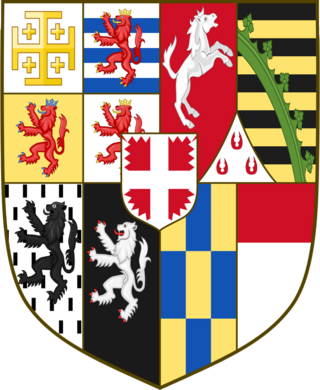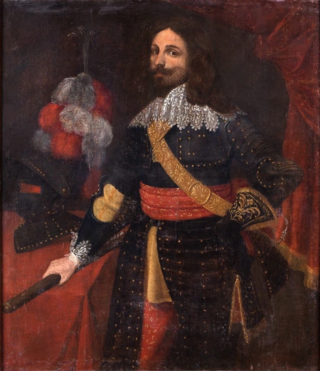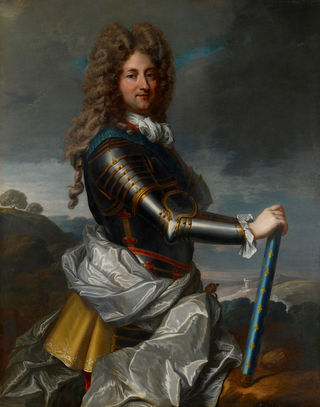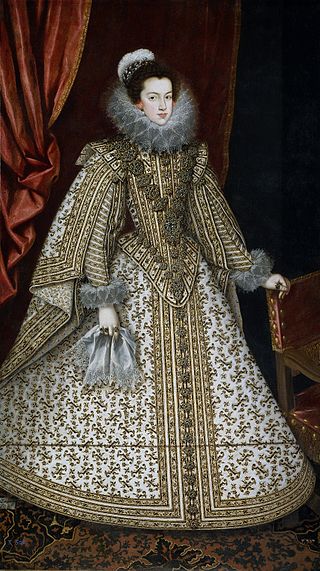Related Research Articles

The House of Bourbon is a dynasty that originated in the Kingdom of France as a branch of the Capetian dynasty, the royal House of France. Bourbon kings first ruled France and Navarre in the 16th century. A branch descended from the French Bourbons came to rule Spain in the 18th century and is the current Spanish royal family. Further branches, descended from the Spanish Bourbons, held thrones in Naples, Sicily, and Parma. Today, Spain and Luxembourg have monarchs of the House of Bourbon. The royal Bourbons originated in 1272, when Robert, the youngest son of King Louis IX of France, married the heiress of the lordship of Bourbon. The house continued for three centuries as a cadet branch, serving as nobles under the direct Capetian and Valois kings.

The House of Savoy-Carignano originated as a cadet branch of the House of Savoy. It was founded by Thomas Francis, Prince of Carignano (1596–1656), an Italian military commander who was the fifth son of Charles Emmanuel I, Duke of Savoy. His descendants were accepted as princes étrangers at the court of France, where some held prominent positions. Upon the extinction of the main Savoy line they eventually came to reign as kings of Sardinia from 1831 to 1861, and as kings of Italy from 1861 until the dynasty's deposition in 1946. The Savoy-Carignano family also, briefly, supplied a king each to Spain and Croatia, as well as queens consort to Bulgaria and Portugal.

Thomas Francis of Savoy, 1st Prince of Carignano was an Italian military commander and the founder of the Carignano branch of the House of Savoy, which reigned as kings of Piedmont-Sardinia from 1831 to 1861, and as kings of Italy from 1861 until the dynasty's deposition in 1946.

William the Silent or William the Taciturn, more commonly known in the Netherlands as William of Orange, was the leader of the Dutch revolt against the Spanish Habsburgs that set off the Eighty Years' War (1568–1648) and resulted in the formal independence of the United Provinces in 1648. Born into the House of Nassau, he became Prince of Orange in 1544 and is thereby the founder of the Orange-Nassau branch and the ancestor of the monarchy of the Netherlands. In the Netherlands, he is also known as Father of the Fatherland.

Marie de' Medici was Queen of France and Navarre as the second wife of King Henry IV. Marie served as regent of France between 1610 and 1617 during the minority of her son Louis XIII. Her mandate as regent legally expired in 1614, when her son reached the age of majority, but she refused to resign and continued as regent until she was removed by a coup in 1617.

Philippe II, Duke of Orléans, was a French prince, soldier, and statesman who served as Regent of the Kingdom of France from 1715 to 1723. He is referred to in French as le Régent. He was the son of Monsieur Philippe I, Duke of Orleans, and Madame Elisabeth Charlotte, Duchess of Orléans. Born at his father's palace at Saint-Cloud, he was known from birth by the title of Duke of Chartres.

Henri II de Bourbon, Prince of Condé was the head of the senior-most cadet branch of the House of Bourbon for nearly all his life and heir presumptive to the King of France from the age of two until he was 12. Henri was the father of Louis, le Grand Condé, the celebrated French general.

Elisabeth of France or Isabella of Bourbon was Queen of Spain from 1621 to her death and Queen of Portugal from 1621 to 1640, as the first spouse of King Philip IV & III. She served as regent of Spain during the Catalan Revolt in 1640–42 and 1643–44.

Christina of Denmark was a Danish princess, the younger surviving daughter of King Christian II of Denmark and Norway and Isabella of Austria. By her two marriages, she became Duchess of Milan, then Duchess of Lorraine. She served as the regent of Lorraine from 1545 to 1552 during the minority of her son. She was also a claimant to the thrones of Denmark, Norway and Sweden in 1561–1590 and was sovereign Lady of Tortona in 1578–1584.

The House of Croÿ is an old European noble family of princely and historically sovereign rank, which held a seat in the Imperial Diet from 1486, and was elevated to the rank of Princes of the Holy Roman Empire in 1594. In 1533 they became Dukes of Arschot and in 1598 Dukes of Croy in France. As a former ruling and mediatized family, it belongs to the Hochadel. In 1913, the family had branches in Belgium, France, Austria and Prussia.

A favourite was the intimate companion of a ruler or other important person. In post-classical and early-modern Europe, among other times and places, the term was used of individuals delegated significant political power by a ruler. It was especially a phenomenon of the 16th and 17th centuries, when government had become too complex for many hereditary rulers with no great interest in or talent for it, and political institutions were still evolving. From 1600 to 1660 there were particular successions of all-powerful minister-favourites in much of Europe, particularly in Spain, England, France and Sweden.

The House of Arenberg is an aristocratic lineage that is constituted by three successive families that took their name from Arenberg, a small territory of the Holy Roman Empire in the Eifel region. The inheritance of the House of Croÿ-Aarschot made the Arenbergs the wealthiest and most influential noble family of the Habsburg Netherlands. The family's Duchy of Arenberg was mediatized in 1810. As such, the Arenbergs belong to the small group of families that constitute the Hochadel.
René III of Renesse, Viscount of Montenaecken, Baron of Gaesbeeck, Lord of Elderen was a Dutch nobleman, who became the 1st Count of Warfusée in 1609. He acquired Gaasbeek Castle in 1615.

The Compromiseof Nobles was a covenant of members of the nobility in the Habsburg Netherlands who came together to submit a petition to the Regent Margaret of Parma on 5 April 1566, with the objective of obtaining a moderation of the placards against heresy in the Netherlands. This petition played a crucial role in the events leading up to the Dutch Revolt and the Eighty Years' War.

Louise-Élisabeth of France was a French princess, a fille de France. She was the eldest daughter of King Louis XV and Queen Maria Leszczyńska, and the twin sister of Henriette of France, and she was the only one of his legitimate daughters who married. She married Infante Philip of Spain, who inherited the Duchy of Parma and Piacenza through his mother in 1748. Infante Philip was her father's first cousin; both men were grandsons of Louis, Grand Dauphin. Thereafter, Élisabeth and her husband founded the House of Bourbon-Parma. She functioned as the de facto ruler of the Duchy of Parma between 1748 and 1759.
Florent of Berlaymont was Count of Lalaing and Berlaymont, and Stadtholder of Namur, Artois, Guelders-Zutphen and Luxembourg, in the service of the King of Spain.

Albert de Ligne (1600–1674), Prince of Barbançon and Arenberg, knight of the Golden Fleece, was a Netherlandish nobleman and military commander in the Thirty Years' War and the Eighty Years' War.

Guillaume de Melun (1588–1635) was a nobleman in the Spanish Netherlands, Governor and Grand Bailiff of the County of Hainaut, and Constable of Flanders, who conspired against the government.

The period between the start of the Beeldenstorm in August 1566 until early 1572 contained the first events of a series that would later be known as the Eighty Years' War between the Spanish Empire and disparate groups of rebels in the Habsburg Netherlands. Some of the first pitched battles and sieges between radical Calvinists and Habsburg governmental forces took place in the years 1566–1567, followed by the arrival and government takeover by Fernando Álvarez de Toledo, 3rd Duke of Alba with an army of 10,000 Spanish and Italian soldiers. Next, an ill-fated invasion by the most powerful nobleman of the Low Countries, the exiled but still-Catholic William "the Silent" of Orange, failed to inspire a general anti-government revolt. Although the war seemed over before it got underway, in the years 1569–1571, Alba's repression grew severe, and opposition against his regime mounted to new heights and became susceptible to rebellion.
Alexander, duke of Bournonville (1585–1656) was a nobleman, soldier, diplomat and conspirator with estates in both the Kingdom of France and the Low Countries.